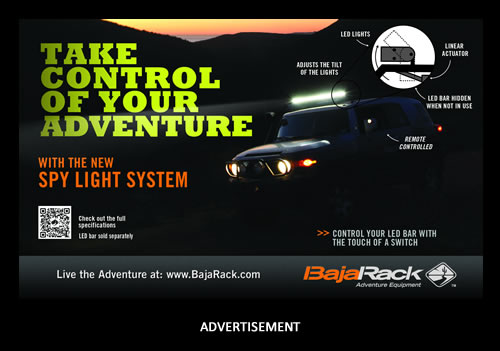Summer 2016
- Details
- By Michael Holland
If you are like me, you don’t have $50-$80k to spend on a new vehicle to take into the backcountry. I don’t have that kind of money for a vehicle—period. For many of us, we have a certain aging truck or SUV (preferably Toyota) that we use to explore the wilds for a day, weekend, or an extended period of time. We buy this or that modification to improve the vehicle and the overlanding experience. However, the key is to not go broke doing so. There are SO many things you can purchase for your vehicle in today’s market that if you’re not careful, you’ll spend excess money and possibly have unnecessary modifications. So, what to buy? What to avoid?
I love to explore the deserts of Utah and Arizona. During the summer months, I travel to mountainous states like Wyoming, Colorado, and Idaho; usually with my wife and daughter. Our trips consist of many weekend jaunts and a few multi-week trips each year. We roughly spend 50-60 nights camping and exploring. The roads we take are generally dirt/gravel with limited slow, rock crawling type of driving. My vehicle of choice is a 1999 Toyota Land Cruiser. I purchased it with 130k miles, and it recently just passed 180k miles. So, what does my vehicle need? What would help us enjoy overlanding even more and want to continue to do it?
I placed a call to my friend and owner of Cruiser Outfitters, Kurt Williams. Kurt is very knowledgeable on overlanding and was willing to share his thoughts and advice on what my truck might need and how to get it installed. I asked Kurt, What are two things every overlander should buy? Without much of a pause, Kurt replied, First, suspension upgrade...the vehicle will be carrying more weight. Second, a refrigerator... to keep food fresh and ready. He has traveled on five continents through different environments and has first-hand knowledge of what works on vehicles and what doesn’t. His exploits have been seen as part of the Expeditions 7 (expeditions7.com), and he is the reality star in the Youtube series, Expedition Overland (xoverland.com). Kurt states: The biggest mistake I have seen is owners not taking trips or adventures because their vehicle doesn’t have all of the latest modifications. The other mistake is that people modify their vehicles with substandard parts. The whole goal of an overland vehicle is to take people to remote places and adventures and to bring them back! Make the vehicle the most reliable it can be."
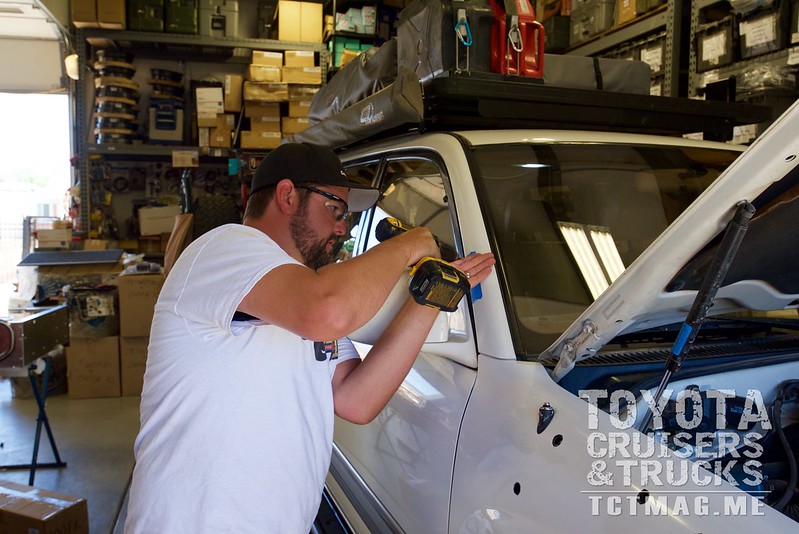
What makes the overlanding community so unique and fun is that everyone’s ride has a rhyme or a reason. Why did I choose Toyota? What made me install rock sliders? What made me choose a ground tent versus a RTT? All of us have our reasons; and below I share mine. Agree? Disagree? No worries. My hope is to make you think and ponder future decisions before dropping some coin. Here is my rationale on purchases and some examples of those.

Functional:Add something to the vehicle that will help it function better. Three prime examples of this are the ARB Outback Drawers, the multifunctional electrical outlet, and the Slee rock sliders. My drawers serve to organize food, gear, and tools. I also added two USB ports and a 12v socket. Sure, this modification isn’t flashy or glamorous; but with today’s technology, I am always recharging something. I needed some rock sliders but wanted something that I could stand on as well to access my roof rack. Slee Offroad from Golden, CO, is a Land Cruiser outfitter; and the step rock sliders they make are perfect. The sliders do the job, in terms of protecting the body with solid functionality as a step to access my items on my roof rack.


Atheistic: Yep, I said it. It’s my vehicle. Does it look good and cool to me? I am the one driving it. It would be crazy for me not to be happy with my ride. I remembered that when I was shopping for a rear bumper and shopped the usual suspects such as Slee, ARB, etc. However, I really didn’t like the looks of them. Just a personal thing. I did like the looks of the rear bumper by Bump It Off Road. I called Mike Smith, the owner, to discuss some custom options I wanted. Within a month, it was shipped to Cruiser Outfitters. Kurt and I installed it, and I couldn’t be happier. It just looked better in my opinion. Personalize your vehicle, whatever your definition, and you will be happy with the end product.
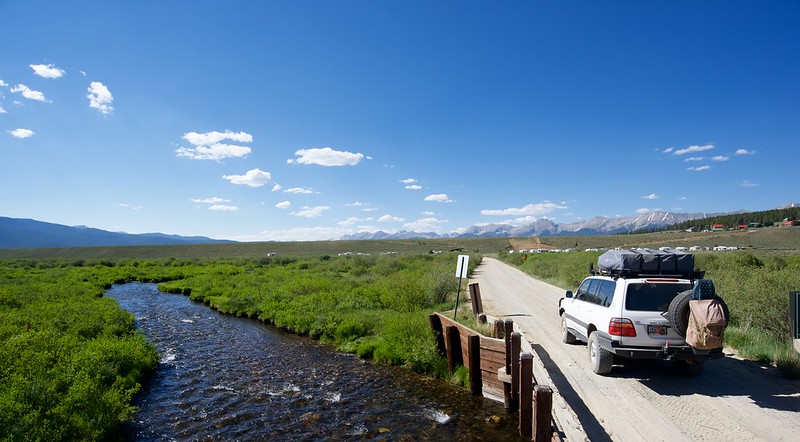
Reliable: Things will get damaged and break, which might jeopardize an entire trip. When I get stuck in a tough spot and all I need is a simple winch extraction, it would be a bummer if my winch didn’t work. The money I would have saved buying the Chinese winch becomes meaningless. If something does break from one of the big companies, they are usually more than willing to warranty an item or make the situation right. Kurt mentioned, One advantage to the big companies is that they do a great deal of product testing before hitting the market. Granted, we all want to save some money, but do yourself a favor and buy products from reliable companies.
One product that comes to mind is an ARB air front locker. There are many lockers out there, but I needed one that I could count on without worry. It’s not something I use every day or even every trip. But, when I need it...it’s ready to go.
Practical: This refers to my vehicle’s needs for what I’m asking it to do. For example, I followed Kurt’s advice and had Cruiser Outfitters install an ARB Old Man Emu suspension to my Land Cruiser. ARB makes different spring weight rates, and I went with the heavy springs. I always think about what modifications I foresee in the future. The ARB suspension improved my vehicle’s ride greatly and handled the weight without issue. My vehicle needs certain things depending on what I’m asking it to do.
The other modification that falls into this category is the 12-volt refrigerator. Simple, practical modifications are just that—simple. But, they make such a difference overlanding. I had heard all the hype on these for a year or two before I took the plunge. Wow, how did I travel without one before? I purchased an ARB 50 Quart fridge from Cruiser Outfitters, and they installed it within an hour. The fridge is a game changer for me. I’m not concerned about buying ice at the next stop; and more importantly, I can carry tasty, healthy, fresh food. I think it should be your first or second purchase!

I recently got back from four weeks of traveling. Throughout my time, I got stopped many times by people asking questions about my vehicle and the modifications. There might be no right or wrong answers. However, here are a few cautions from Kurt. Don’t let waiting to modify your vehicle stop you from going on your next adventure. Also, always consider the weight you are adding to your vehicle because handling and braking will be affected.

My decisions and purchases span a four-year period. This gave me time to process decisions on expenses, listen to and read about other people’s experiences, and save the necessary money. Give the guys at Cruiser Outfitters a call. They would be happy to answer your questions and overhaul your ride for your next overland adventure. See you out there...
Contacts and Information
Cruiser Outfitters
801-563-1277
cruiseroutfitters.com
A Salt Lake City, Utah company since 1992. One of the largest ARB dealers in the US. Direct importer of parts from Japan and Australia. Specializing in the Toyota Land Cruiser platform. Over 3,000 parts in stock and shipped daily.
Bump It Off Road
970-590-5748
bumpitoffroad.com
Located in Colorado. Mike specializes in custom steel fabrication. Bumpers, sliders, etc. Got an idea, give him a shout!
Slee Offroad
888 4X4-Slee (US Only)
888 494-7533 303 278-8287
Located in Golden, Colorado. Slee Offroad specializes in all things Land Cruiser. They make some of their own custom parts for the 80, 100, and 200 series.
More Photos!
[flickr set=72157676813405876]
To get your copy of theSummer 2016 Issue: |
- Details
- By Adam Tolman
If you spend any amount of time on YouTube watching Australian off-road videos, like I do, you have heard them mention “Touring.”
Read more: 80 Series “Ultimate Touring” Slinky Long Travel Suspension
- Details
- By Beau Johnston
We are in a golden age of outdoor and camp cooking, with each year seeing new companies starting to produce quality cookware at great prices. The problem is, with all of these new companies pining for us to buy their products, buying a new set of camp cookware can be confusing. Let’s cut through the hype and dig deep into the material science behind many of these cookware designs. Doing so will allow us to see the pros and cons of each material and help ensure you choose the cookset with the right material for your cooking needs. I am going to apologize now for, as you will soon read, my geeking out about this topic. I will freely admit that I am a nerd and, if you have attended one of our cooking classes, tend to get overly excited about the science that is going on behind the scene.
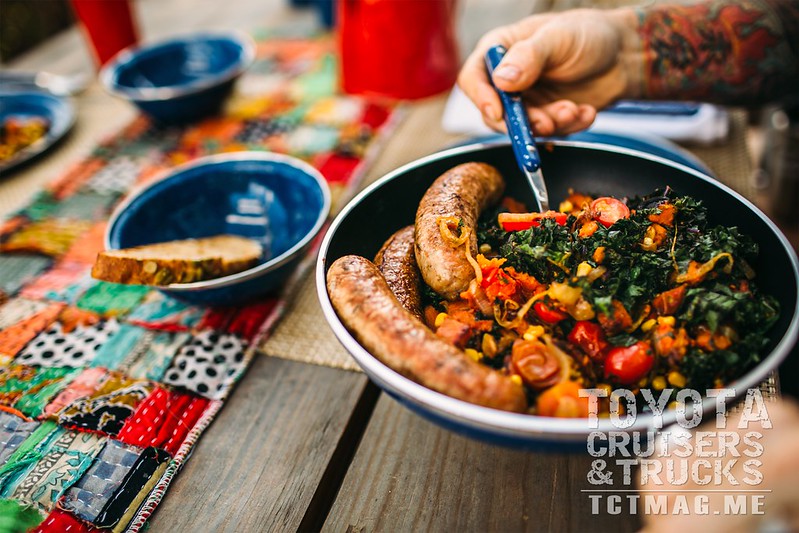
Resistance to heat transfer also means they are prone to hot spots. This is due to the material’s inability to conduct heat through itself and away from the heat-source. Cookware manufactures can combat hot spots by increasing the material thickness. The increased thicknesses essentially dissipating the heat over a larger area. This is a double-edged sword, however, as the greater the thickens the more energy is needed to heat the cooking surface.
Now that we understand how heat transfer from the flame-side to the cooking side of a pot or pan we must think about how that heat is retained in the material. A pot or pan’s heat capacity is a function of the its material density and the specific heat. The material’s specific heat can be thought of as the amount of energy needed to increase the temperature of the material. When multiplied by the density we get a variable that helps us differentiate between the different materials.

Now that we understand how a material’s thermal properties can affect cooking performance we must turn our attention to an often overlook aspect, a material’s reactivity. Highly acidic ingredients or alkaline ingredients, tomatoes and onions (respectively), can create a chemical reaction with cookware material. This can cause the material to degrade and impart metallic flavors into the meal. Although the amount of metal that reacts with food and can be ingested is very small, there are some health concerns from prolonged exposure.
One way camping cookware manufacturers work around reactivity concerns is through the use of coatings like TeflonTM or enamel. These coatings generally serve two purposes when applied to the cooking surfaces. Firstly, they create a barrier between the reactive material and the food, preventing a chemical reaction from taking place. Secondly, they create a non-stick surface which allows food to brown without sticking.
Although widely used, coatings do have their limitations and are only as good as their adhesion to the base material. Excessive localized or prolonged exposure to heat can degrade this adhesion.

Additionally, coatings can be degraded by repeated abrasion. Once a coating is compromised, foods can begin to react with the base material, essentially eating underneath the coating. Eventually enough of the coating is detached from the base metal that if flakes off into the food. As with death and taxes, coatings are guaranteed to fail.
Conversely, nonferrous metals like aluminum and titanium can undergo a process called anodizing. Unlike coatings, which require adhesion to stick to the base material, the anodizing process converts the base material’s surface into an anodic oxide layer. Because the anodizing process chemically alters the base metal’s surface, it is less susceptible to mechanical and thermal degradation. This molecular alteration of the base material reduces the metal’s reactivity and improves the nonstick properties. Although the anodic oxide layer can eventually be compromised, anodizing is a great alternative to simply coating reactive materials with enamel or TeflonTM.
Now that we understand the science behind each of the material options let’s take a look at how the four most popular camp cookware materials measure up against each other.
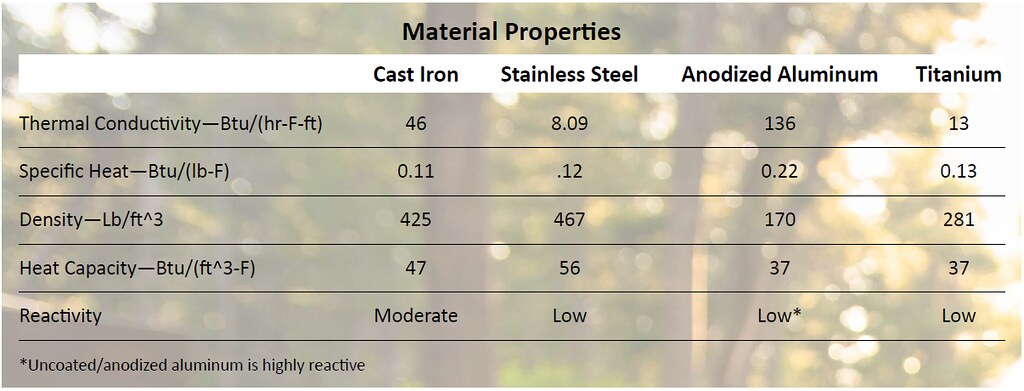
The vast majority of our camp cooking is done using GSI’s Pinnacle line of cookware. It’s anodized aluminum body distributes heat uniformly across the cooking surface, even when cooking over the small burners found in modern cook stoves. The Pinnacle line also utilizes new Teflon coating technology on the cooking surface to produce a great nonstick surface. The aluminum’s exceptional thermal conductivity more than makes up for its relatively low heat capacity.
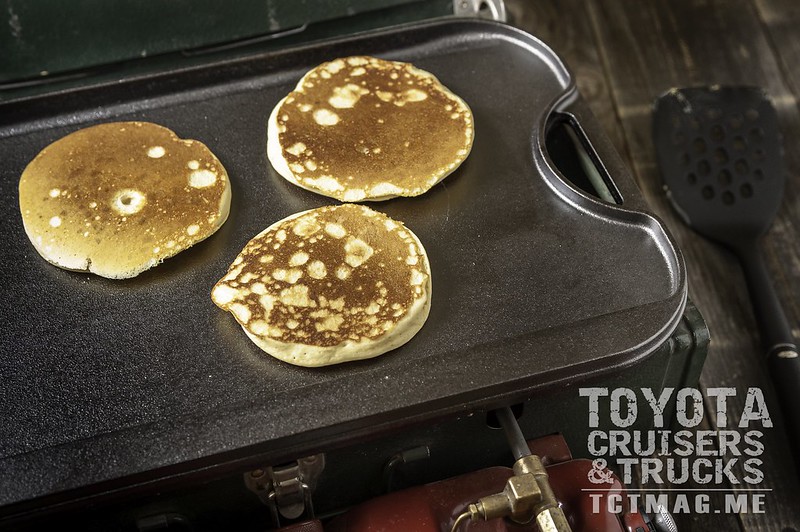
Although the majority of our camp cooking is done with the anodized aluminum cookware, there is still a special place in my heart for cast iron cookware. It is the style of cookware I grew up camping with and the material of choice for generations before me. Although it takes longer to heat up, and is prone to hot spots if heated too quickly, cast iron’s heft and heat capacity still makes it my go-to cookware material when I want to perfectly brown meat or saute vegetables.

So I guess, in a sense, there really isn’t one material that is the be all and end all for camp cookware. It would be easy to say, based on material properties, you should go and buy cookware made from a certain material but it isn’t that easy. Each one is really suited to different cooking needs. By selecting a material that best suits your cooking needs you can guarantee years of enjoyable camp cooking.
I would like to send a special thank you to Lodge Manufacturing Company and GSI Outdoors for answering all of my questions related to this article. We own, and continue to enjoy cooking with, equipment from both of these companies.
More Photos!
[flickr set=72157672871950164]
To get your copy of theSummer 2016 Issue: |
- Details
- By Jonathan Harris
Why do you attend off-road events? It’s a question that I often ask people who frequent organized events.
By Jonathan Harris: FJ Summit CoDirector. Special thanks to CoDirector Matt Robb for demographic information and CoFounder Time Terleski for historical background.
Photos by Rusty Childress, Main Event Imaging
Is it to experience off-roading in a safe, organized, environment? Is it to get new ideas for vehicles upgrades? Is it to spend time with old friends and meet new people? For me events are always for the later. Over the years, many off-road events have sparked meaningful relationships and some of my best friends came out of chance meetings with people on the trail, at vendor booths, at the group dinners and of course, at the raffles. This desire to connect with people was what brought me to the FJ Summit, and what has kept me coming back for more.

The FJ Summit started like many other events, on an online forum. A “national get-together for Fj Cruiser forum members” was first conceived in July 2006 on FJ Cruiser Forums. Jason Gottlieb (Bostonian1976) first proposed the idea and solicited inputs from forum members as to where to hold a “National Get-Together”. A spirited debate as to location ensued with the East Coast. Arkansas, Kansas, Texas, the Black Hills, Moab and Colorado being considered. “Cruiserpalooza”, an early working name, was starting to gel. Forum members including ( but not limited to ) Bostonian1976 (Chairman), CO-Jeff , Castle Rock FJ, VTFJC , FJR Colorado (Trail Boss), GsGmac, Valkyrie, T2Cruiser, Shane4x4, Miss FJ and The Nookie were the first participants in organizing what would later be named, by forum vote, “FJ Cruiser Summit”.

Five individuals. Jason Gottlieb, Seth Kovanic, Jeff Thompsen, Tim Terleski and Ty! Boyack made up the official Co-Directors year one. A not-for-profit corporation was formed, FJSummit.org, Inc. and the FJ Summit was born.
Year one could have been the last, if not for the terrific support and participation of the Toyota Trail Teams. Taking on the responsibility to be Trail Leaders, their experience and expertise made for a safe and successful event the first two years. In following years their expertise and mentorship was passed through the ranks and the FJ Summit eventually was able to take on these responsibilities. This process of passing the torch has continued every year since.

Fj Summit 2007 had approximately 375 participants with close to 200 vehicles. Ouray, Colorado, dubbed “The Switzerland of America” and the surrounding terrain proved to be the ideal location! What was discovered that first year was that FJ Summit not only brought together the drivers and their vehicles, it included their families as well. So many friendships were made and the realization that the event became a family oriented vacation destination resulted in the this unique off road event. Those first year participants spread the word and the foundation for the incredible growth, the incredible camaraderie, the generous charity and the continued fun that FJ Summit has become!

Over the year’s the Summit has grown to become one of the largest Toyota 4x4 events in the nation. Summit X had a total of 409 registered vehicles with 860 adults and 150 children 11 years of age or under for a total of 1,010 total participants. For perspective, the population of Ouray is about 1,100! Summiteers came from all across North America with representation from 43 states and Canadian provinces.

My favorite aspects of the Summit are the family friendly environment and the opportunity to introduce new off-roaders to the activity as a husband and father myself, I can say the Summit is hands down the best off-road event for families. With easy to moderate trails available, great accommodations and activities in ouray and activities for kids, there is something for everyone. Each year we have attendees ranging from those who have never shifted into 4x4 to world renowned expert drivers. For the former, we provide a 4x4 101 class, by Trail Teams alum, Brian “Woody”, Swearengen. We also provide recommendations for new drivers on easier trails and have our wonderful trail leaders work with them throughout the day.
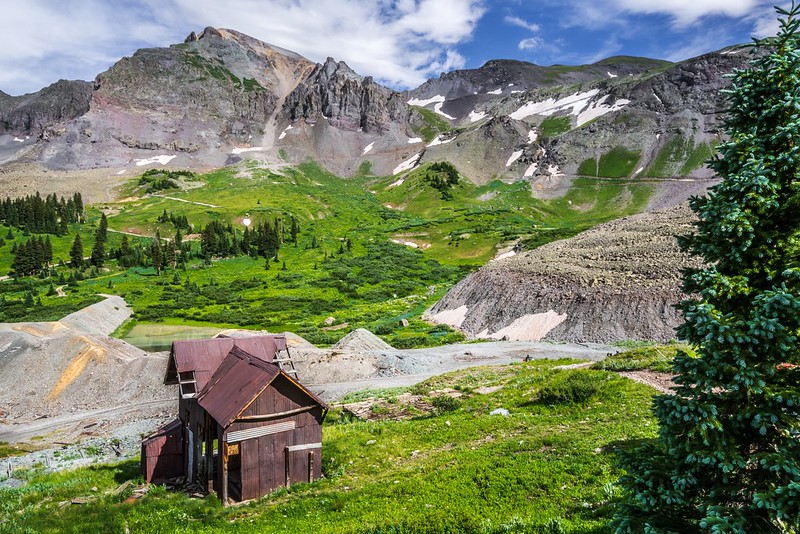
Although the Summit is managed by four CoDirectors (Matt Robb, Chris Davis, James Krieger, and myself, we receive tremendous support from many of the founders who still attend each year. The event could not happen without our volunteers. All of those people that you meet, leading trails, folding shirts, stuffing swag bags and selling items at the store do it for the love of the event and the people around them. I am always blown away and humbled to have each and every one of them as part of the team.
If you have never attended the Summit in the past or are an old timer, we would love to see you at Summit XI. I think you will enjoy what you see. Until then, see you on the trail!

To get your copy of theSummer 2016 Issue: |









